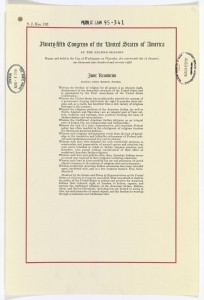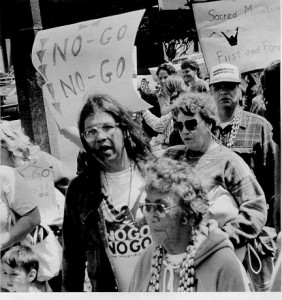
The American Indian Religious Freedom Act stemmed from numerous protests in the 1970s against the U.S. government’s discrimination of religious and cultural practices and the infringement of the government on the natives rights to practice their religion freely. AIRFA was meant to fix this problem by explicitly stating that Native Americans had the right to religious freedom, as defined by the constitution. This law, besides allowing tribes to partake in their religious ceremonies was also supposed to protect sacred sites by making companies or the government consult tribes on the importance of a place before doing anything to the land. It stressed that they should be sympathetic to the Native American religions. It was also hoped by many that it could help repatriate land taken from tribes that had religious and sacred meaning. This act was supposed to be the perfect step in the right direction, but instead it actually reduced the ability for Native Americans to exercise their freedom of expression and religion. Now, the only way that tribes could protect their land was going through the court system, which was already a place of discrimination and mistreatment towards Native Americans. When cases were brought to trial, the burden was now placed on the tribes to prove that their religion was important and that their site of practice was indispensable to their religion and existence. To prove to the court that they need the land, they sometimes have to speak about very private and sacred rituals, sometimes things that their religion forbade them to discuss. Almost every court case and application to take back land, occupy land for a particular ceremony, or protect a sacred site was denied.
It is clear that the act was superficial and useless. The government and companies saw it as guidelines that you only sometimes had to follow. It was actually stated by a government official when the law was being made, that it would not actually change anything about how the government used native lands and it would not lead to many modified practices. So while the tribes thought this law was a step towards reclaiming their religion and history, the government saw it as an unimportant nicety. A significant case that is an example for just how ineffective the law was, is Lyng versus Northwest Indian Cemetery Protective Association. In this case, Yurok, Karok, and Tolowa tribe members in California tried to stop the Forest Service from building a 6-mile road for logging straight through land that was at the core of their religious beliefs. Many people consulting on the case stated that the road shouldn’t be built, and the Forest Service even admitted that the road might not make a difference in logging and job production. However, the Supreme Court made the decision that the first amendment could provide no protection to the land because the government had no intent on affecting the religion and it did not coerce tribe members to give up their beliefs. Also, the benefit that the road could have for society, it was ruled, was more important than maybe destroying sacred land. AIRFA could not protect the land either because it only stated that the government and companies must be sensitive to religious practices, but there was no law forbidding the destruction of sacred land.

The act was finally amended in 1990 but then was overturned because it was ruled that congress couldn’t make a law that protected the practicing of religion free from government interference.
NAGPRA is seen as replacing this act, and although it is much more effective, I believe we can take away important lessons and information from the AIRFA failure that could help improve our understanding of how well NAGPRA actually works and how to improve the protection and repatriation of sacred objects, land, and human beings. A fundamental problem with AIFRA was that the government and public were uneducated when it came to Native American religion and how significant land was to them. The governments were not sympathetic to different tribes beliefs because they did not understand what was so important. Another issue was that the Native Americans had to go through an already biased court system to get what they wanted. They also had to deal with the public and law enforcements stereotypes of them being a dead people and culture. Looking at this failed law can help us critically examine NAGPRA and our institutions and systems to see what has changed for the better and what problems continue to this day that need to be improved.
Sources cited and for further reading:
http://nativeamericannetroots.net/diary/1322
http://berkleycenter.georgetown.edu/cases/lyng-v-northwest-indian-cemetery-protective-association
Picture 1:
http://recordsofrights.org/records/220/american-indian-religious-freedom-act
Picture 2:
http://faculty.humanities.uci.edu/tcthorne/History12/sacredlands.htm
